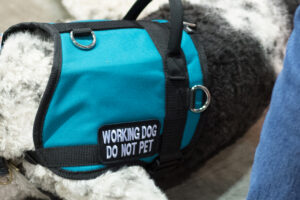K9 CORNER
By Mary Peter
 When teaching veterans how to train the K9 that becomes his or her service dog, veterans must ensure that, when in public places their dog is wearing its vest at all times.
When teaching veterans how to train the K9 that becomes his or her service dog, veterans must ensure that, when in public places their dog is wearing its vest at all times.
It is especially important for the veteran and the K9 so that service dogs, and/or service dogs-in-training are properly identified; and, to minimize public interference.
Of course, the dog’s vest always bears a patch with the message: “Service Dog – Do Not Pet” prominently displayed. Unfortunately, that identifier is commonly overlooked or ignored.
Dogs are such a universal part of American life and culture as family pets, that we don’t often think about them serving a critical therapeutic purpose, or that, when working as service dogs they are functioning no differently than medical equipment such as a wheelchair or oxygen tank.
That’s how service dogs are classified by the American Disabilities Act, as medical equipment.
For veterans who struggle with Post Traumatic Stress Disorder (PTSD), Traumatic Brain Injury (TBI), or Military Sexual Trauma (MST), they bear invisible scars and the service dog they train develops a unique bond with them.
The K9 has the ability to smell the veteran’s cortisol/adrenaline levels that rise from stress and anxiety; and then take action to alleviate it. With this innate skill the animal is able to wake veterans from nightmares and flashbacks, return their focus to the present, and reduce the severity of such episodes.
Service dogs are always tuned in, always reading their veteran and “working” even when they may appear to be just lazily relaxing on the floor!
It is the progress veterans make with their service dog that enable them to regain their self-confidence, to reengage in the everyday living from which many had self-isolated. Progress is gained from seemingly uneventful, but successful trips to a supermarket, a diner, or maybe Lowe’s or Home Depot.
But, their progress can be sharply impeded when they encounter people in public places whose momentary whim to pet a dog ignores both the veteran and the conspicuous message shared on the dog’s vest. Adults are often more problematic than children.
“May I pet your dog?”
The answer the public needs to learn is a firm “No.”
“No, it’s a service dog and that distracts its attention from the work it’s doing for me.”
Most people understand this but some insist on pushing further. “Why can’t I pet your dog?” Apparently their amusement comes first. Some will ask the dog’s name, or try to call and get its attention, even after being told they are an unwanted distraction. Some have even tried to feed them.
Our training includes regular exercises that expose our veterans to the same rude and intrusive remarks and behaviors from the public so that they are prepared and well-positioned to educate rather than argue.
_______________________
EDITOR’S NOTE: Mary Peter is the founder and executive director of training operations of K9 Partners for Patriots, a nonprofit dedicated to veteran suicide prevention, based in Brooksville, Florida.